╔
O Porto de Leixões e o Titan de Matosinhos
Foi com grande perplexidade que, a 12 de abril de 2012, Matosinhos e o país assistiram e tomaram conhecimento de uma grande explosão no Porto de Leixões, na sequência do início dos trabalhos da construção do novo Terminal de Cruzeiros. Este acidente, com vítimas mortais, provocou também o colapso e fragmentação do titan localizado no molhe sul, debruçado sobre a praia de Matosinhos. Tratava-se de uma significativa perda patrimonial que afetava a Memória da cidade e da região, de um modo que parecia irrecuperável. A APDL – Administração dos Portos do Douro, Leixões e Viana do Castelo, S.A. – todavia recolheu e salvaguardou todos os fragmentos possíveis do histórico mecanismo, prometendo que procederia à sua regeneração.
It was with great perplexity that, on April 12, 2012, Matosinhos and the country watched and learned of a major explosion at the Port of Leixões, following the start of construction work on the new Cruise Terminal. This accident, with fatalities, also caused the collapse and fragmentation of the titan located on the south pier, overlooking the Matosinhos beach. This was a significant patrimonial loss that affected the Memory of the city and of the region, in a way that seemed irrecoverable. APDL – Port Administration of Douro, Leixões and Viana do Castelo, S.A. – however collected and safeguarded all possible fragments of the historical mechanism, promising to proceed with its regeneration.
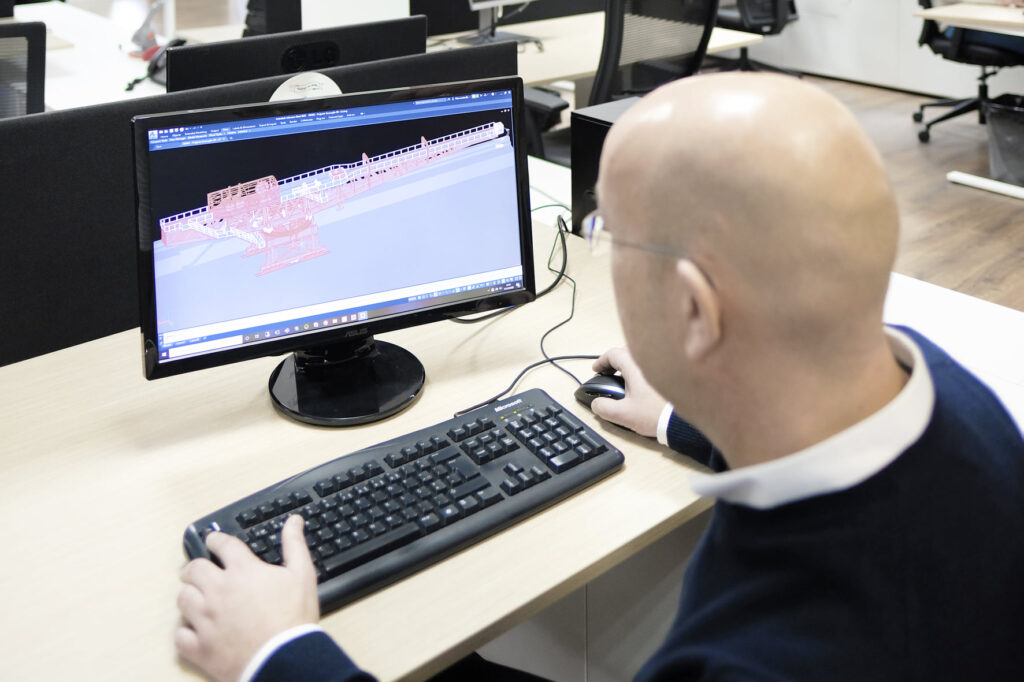
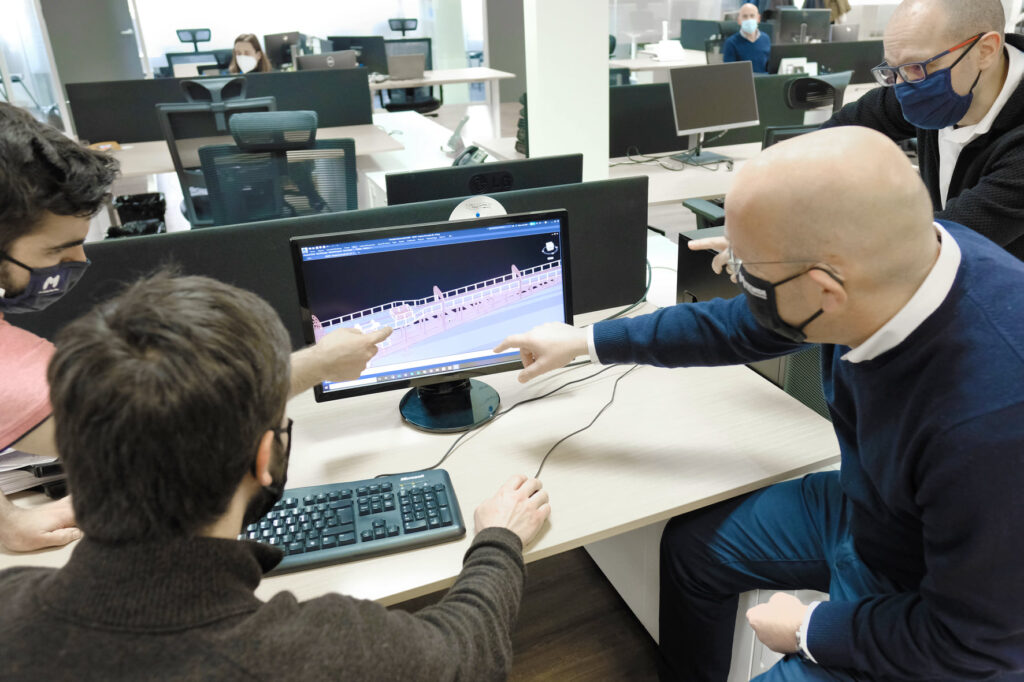
Foram precisos vários anos e múltiplos estudos, consultas e pareceres para a recuperação do Titan depois do colapso ocorrido em 2012. (© Sérgio Jacques; Fuente: APDL, 2020).
It took several years and multiple studies, consultations, and opinions to recover Titan after its collapse in 2012. (© Sérgio Jacques; Source: APDL, 2020).
Oito anos depois, em 2020, após múltiplos estudos, consultas e pareceres, as operações de restauro, conservação, consolidação e reconstrução do centenário e gigantesco guindaste tiveram início e, após um intenso trabalho de restauro e de reconstrução, em outubro de 2021 o gigantesco e icónico guindaste voltou a marcar a paisagem portuária e a Identidade de Matosinhos e da região do Porto.
Eight years later, in 2020, after multiple studies, consultations and opinions, the restoration, conservation, consolidation and reconstruction operations of the centenary and gigantic crane began and, after intense restoration and reconstruction work, in October 2021 the gigantic and iconic crane once again marked the port landscape and the Identity of Matosinhos and the Porto region.
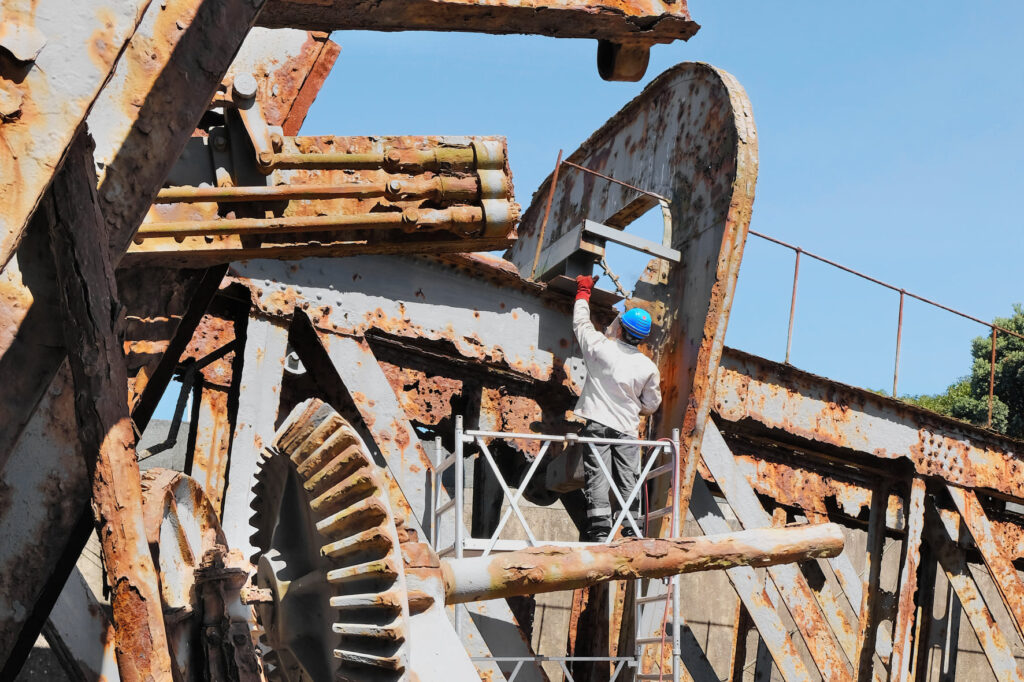
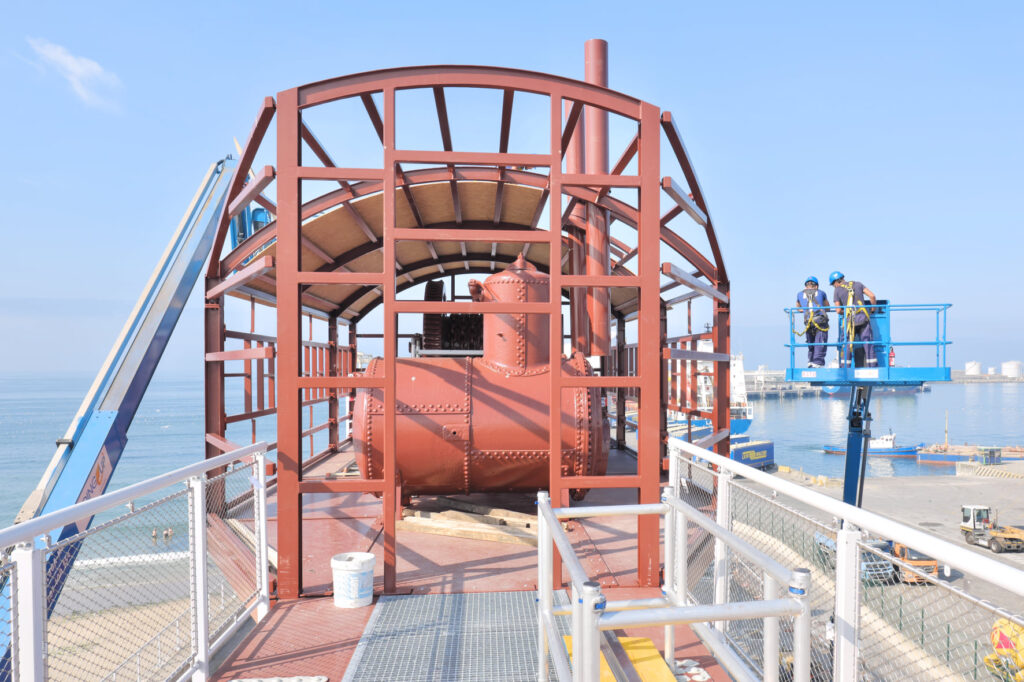
Em 2020 tiveram início as operações de restauro, conservação, consolidação e reconstrução do centenário guindaste, que em 2021 voltou a marcar a paisagem do Porto de Leixões. (© Sérgio Jacques; Fuente: APDL, 2020).
In 2020 the operations for the restoration, conservation, consolidation, and reconstruction of the centenary crane began, which in 2021 will once again mark the landscape of the Port of Leixões. (© Sérgio Jacques; Source: APDL, 2020).
Mas, que guindaste era este e porquê a sua relevante importância patrimonial e histórica?
But which crane was this and why its relevant patrimonial and historical importance?
Desde a sua origem, nos finais do século XIX, que o porto de Leixões possui dois “colossos” metálicos. Um em cada um dos extensos e monumentais molhes que definem a enseada portuária. Únicos no mundo, os “titans” são gigantescos guindastes que documentam de forma privilegiada a época da arquitectura e engenharia do ferro e da energia a vapor. Irmãos próximos de outros famosos monumentos metálicos de grandes dimensões do final de oitocentos, como a torre Eiffel (1889) ou, na vizinha cidade do Porto, as pontes Maria Pia (1877) e Luís I (1888) ou o mercado Ferreira Borges (1885), os titans foram fulcrais na edificação do porto de Leixões – a maior obra de engenharia realizada em Portugal no século XIX. Afinal, foi graças à sua força e à sua avançada decidida sobre o mar que os molhes portuários foram construídos no término desse século. Importa, pois, começar por perceber o porquê do aparecimento deste porto.
Depois de séculos de projectos, indefinições, sonhos, entraves e utopias, e decididamente impulsionado pela trágico naufrágio do vapor “Porto” na barra do Douro em 1852, foi, por fim, a 13 de julho de 1884, que se iniciou a construção do porto artificial de Leixões – uma alternativa, que há séculos se impunha, à crescente perigosidade da barra do grande rio e às enormes dificuldades que as embarcações tinham para aportar nos cais do Porto e Gaia: o estuário do Douro era há muito um cemitério de barcos e de homens. Mas o projeto não era fácil. O novo porto seria uma obra titânica!
Since its origin, at the end of the 19th century, the port of Leixões has had two metallic “colossus”. One in each of the extensive and monumental piers that define the port inlet. Unique in the world, the “titans” are gigantic cranes that document in a privileged way the age of architecture and engineering of iron and steam power. Close brothers of other famous large metallic monuments of the late 1800’s, such as the Eiffel Tower (1889) or, in the neighbouring city of Oporto, the bridges Maria Pia (1877) and Luís I (1888) or the Ferreira Borges market (1885), the titans were pivotal in the building of the port of Leixões – the largest engineering work carried out in Portugal in the 19th century. After all, it was thanks to their strength and their decisive advance over the sea that the port jetties were built at the end of that century. It is therefore important to begin by understanding why this port came into being.
After centuries of projects, vagueness, dreams, obstacles, and utopias, and decidedly driven by the tragic shipwreck of the steamer “Porto” in the Douro bar in 1852, it was finally on July 13th, 1884, that the construction of the artificial port of Leixões began: the Douro estuary had long been a graveyard for boats and men. But the project was not easy. The new port would be a titanic task!
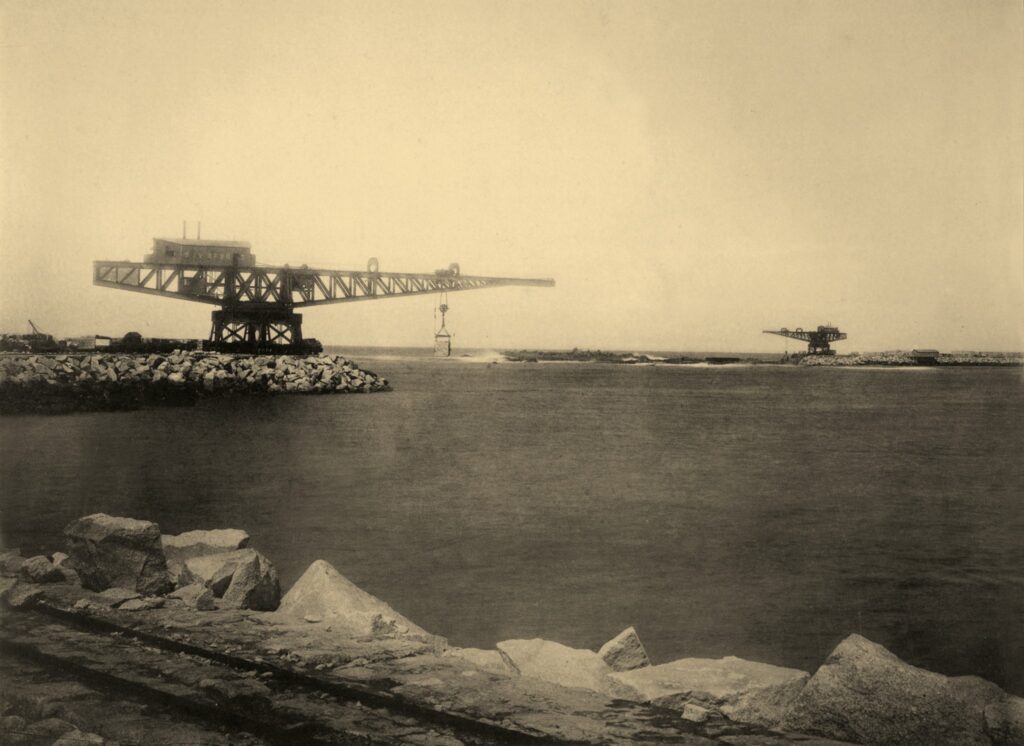
Desde a sua origem, nos finais do século XIX, o Porto de Leixões possui dois “colossos metálicos”. (© Emílio Biel; Fuente: APDL; finais do séc. XX).
Since its origin, at the end of the 19th century, the Port of Leixões has had two “metallic giants”. (© Emílio Biel; Source: APDL; end of the 20th century).
Baptizado com o nome dos rochedos sobre os quais assentou parte significativa dos molhes, Leixões foi projetado pelo Eng. Afonso Nogueira Soares e construído pela empresa francesa “Dauderni et Duparchy” que havia vencido o concurso internacional (foi a única a concorrer), com um valor de adjudicação traduzido na, para a época, fabulosa quantia de 4 milhões e 489 mil réis. Nomeado pelo dono da obra – o Estado português – o autor do projecto supervisionou durante os anos seguintes a empreitada e, não obstante a complexidade de que se revestiu a edificação desta estrutura portuária, os prazos foram cumpridos: após a entrega provisória em 1892, a definitiva deu-se em 1895. Na base do sucesso destas obras encontram-se vários factores. Dois deles, no entanto, são incontornáveis: a dupla dos gigantescos guindastes movidos a vapor – os titans – que, bloco após bloco, foram erigindo sobre o fundo marinho e rochoso os molhes que definiram o porto.
Com efeito, a construção inicial do porto artificial consistiu, fundamentalmente, na formação de uma grande enseada, com cerca de 95 hectares, delimitada pela construção de dois extensos paredões ou molhes: o do lado norte com 1579 metros e o do lado sul com 1147 metros. E, entre eles, uma abertura de 220 metros permitindo a entrada e saída das embarcações. Além destes paredões foi também construído, no extremo do molhe norte, um quebra-mar que, elevando-se apenas um metro acima do zero hidrográfico, prolongava em mais algumas centenas de metros aquele paredão. Para a construção dos molhes foi utilizado o granito de pedreiras próximas, a mais importante das quais foi a do Monte S. Gens (Custóias) que se viu ligada a Leixões por uma linha de comboio, com cerca de sete quilómetros de extensão e construída expressamente para esse fim.
Após a sua chegada aos estaleiros e oficinas, que foram montados em Matosinhos (para apoio à edificação do molhe sul) e Leça da Palmeira (para o molhe norte), as pedras eram então trabalhadas e conglomeradas por um grande número de operários – um verdadeiro formigueiro humano, onde se incluíam mulheres e crianças – dando origem aos enormes blocos graníticos que formariam os paredões e que chegavam a atingir as 50 toneladas. Tal peso, embora pouco prático para o manuseamento destes blocos na obra, era a garantia da futura estabilidade e resistência dos molhes face ao impacto e à ferocidade do mar. Mas era, de facto, um problema. Como proceder para transportar, erguer e posteriormente depositar no local desejado os ciclópicos e pesadíssimos blocos graníticos?
Para um grande problema só uma solução “titânica”. Com efeito, para resolver esta questão a empresa construtora, a “Dauderni & Duparchi”, encomendou às famosas oficinas francesas “Fives”, em Lille, dois gigantescos e poderosos guindastes. Graças à resistência do ferro em que foram construídos e à força da energia a vapor que os movia, foram eles, com efeito, que tornaram possíveis tais operações. Tais características, associadas ao seu aspeto colossal – quase 69 metros de comprimento, pesando 420 toneladas e erguendo-se até cerca de 17 metros de altura – justificaram a sua designação: “titans”. Mais de vinte anos antes do aparecimento do gigante e tragicamente célebre navio “Titanic”, naufragado em 1912…
Com envolvimento alemão no seu fabrico, os potentes guindastes foram transportados das oficinas francesas da “Fives”, montados em Leixões e dirigidos durante os primeiros anos pelo técnico francês Lecrit. Movidos a vapor, no seu topo impunha-se a fumarenta “casa das máquinas” que abrigava as caldeiras de vapor de 50 cavalos e os operários que as alimentavam a carvão. Deslocando-se cada um no seu molhe, sobre carris cuja via chegou a ter dois quilómetros, desde os estaleiros onde eram montados os blocos até à extremidade dos paredões, e depositando, mar adentro, bloco após bloco, os titans foram por isso cruciais na edificação do porto. Auxiliando-os, salientaram-se também as “caranguejeiras” que, igualmente movidas a vapor, levavam os blocos até ao guindaste.
Named after the rocks on which a significant part of the jetties was built, Leixões was designed by Afonso Nogueira Soares and built by the French company “Dauderni et Duparchy” which had won the international contest (it was the only one to bid), with an adjudication value translated into the, at the time, fabulous amount of 4 million 489 thousand réis. Appointed by the owner – the Portuguese State – the project author supervised the construction for the following years and, despite the complexity of the construction of this port structure, the deadlines were met after the provisional delivery in 1892, the final delivery took place in 1895. Several factors underpinned the success of this work. Two of them, however, are undeniable: the pair of gigantic steam-powered cranes – the titans – which, block after block, were erected on the rocky seabed, the piers that defined the port.
In effect, the initial construction of the artificial harbour consisted, fundamentally, in the formation of a large inlet, with about 95 hectares, delimited by the construction of two extensive breakwaters: the north side with 1579 metres and the south side with 1147 metres. Between them, an opening of 220 metres allows for the entrance and exit of boats. Besides these jetties, a breakwater was also built at the end of the north pier. Rising only one metre above the hydrographic mark, it extended the jetties by a few hundred metres. For the construction of the breakwaters, granite from nearby quarries was used, the most important of which was the one from Monte S. Gens (Custóias) that was connected to Leixões by a train line, about seven kilometres long and built expressly for that purpose.
After their arrival at the shipyards and workshops, which were set up in Matosinhos (to support the construction of the south pier) and Leça da Palmeira (for the north pier), the stones were then worked and conglomerated by numerous workers – a veritable human anthill, which included women and children – giving rise to the enormous granite blocks that would form the walls and which could weigh up to 50 tons. Such weight, although impractical for the handling of these blocks on site, was the guarantee of the future stability and resistance of the piers against the impact and ferocity of the sea. But it was, in fact, a problem. How to transport, erect and then deposit the huge, heavy granite blocks in the desired location?
For a big problem, only a “titanic” solution. In fact, to solve this problem, the construction company “Dauderni & Duparchi” commissioned two gigantic and powerful cranes from the famous French workshop “Fives” in Lille. Thanks to the strength of the iron, they were made of and the force of the steam power that moved them, it was they, in fact, that made such operations possible. Such characteristics, together with their colossal appearance – almost 69 metres long, weighing 420 tonnes and rising to a height of about 17 metres – justified their designation: “titans”. More than twenty years before the appearance of the giant and tragically famous ship “Titanic”, sunk in 1912…
With German involvement in their manufacture, the powerful cranes were brought from the French workshops of “Fives”, assembled in Leixões, and directed during the first years by the French technician Lecrit. Powered by steam, on top of them stood the smoky “engine room” which housed the 50-horsepower steam boilers and the workers who fuelled them with coal. Moving each one on its own pier, on rails whose track reached two kilometres, from the shipyards where the blocks were assembled to the end of the walls, and depositing, into the sea, block after block, the titans were therefore crucial in the construction of the port. Assisting them were also the “crab boats” that, also powered by steam, carried the blocks to the crane.
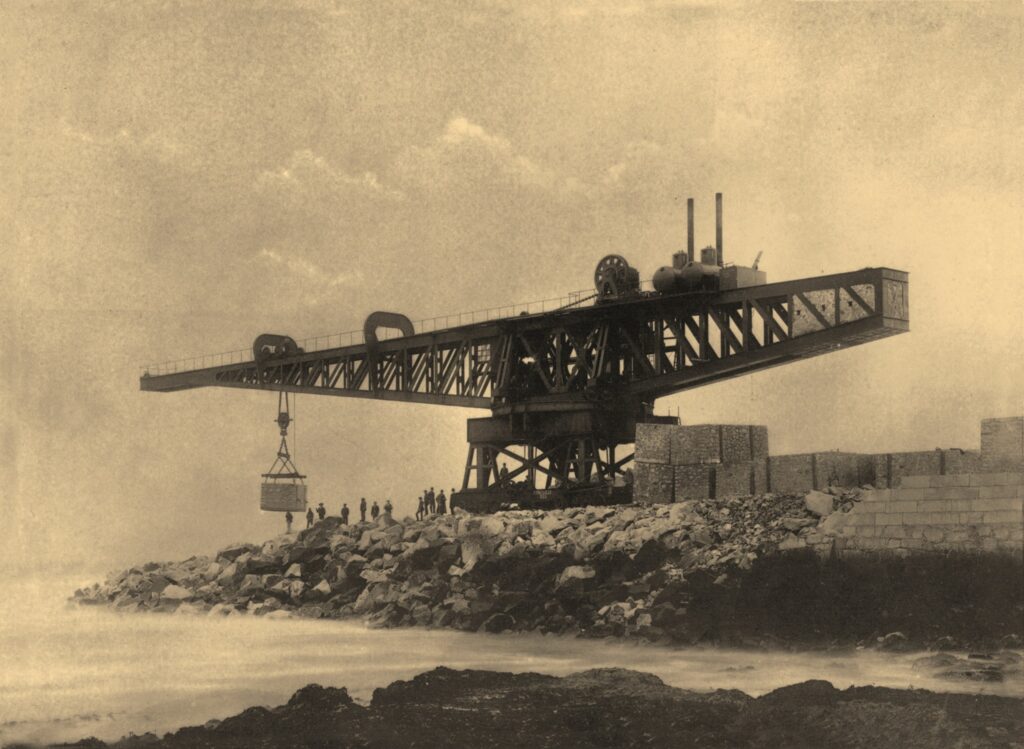
Após a edificação dos molhes, os Titans continuaram a ser utilizados nas reparações dos paredões, na sequência de danos provocados pela ação tempestuosa do mar. (© Emílio Biel; Fuente: APDL; finais do séc. XX).
After the construction of the jetties, titans continued to be used to repair the walls, following damage caused by the stormy action of the sea. (© Emílio Biel; Source: APDL; end of the 20th century).
Após a edificação dos molhes, os titans continuaram a ser utilizados nas reparações dos paredões, na sequência de danos provocados pela ação tempestuosa do mar. De resto, o titan do molhe norte foi protagonista das consequências de um fortíssimo temporal ocorrido na noite de 22 para 23 de dezembro de 1892, caindo ao mar. Sobre esse acontecimento refletiu Alberto Pimentel em 1893: “Não se doma facilmente o oceano, não se modifica, sem ter que vencer grandes dificuldades, a obra espontânea da natureza. Mas a ciência, a engenharia hidráulica, confiada nos seus poderosos recursos, ia encetar a luta com o oceano e estava certa de vencê-lo, não sem violentas refregas e frequentes conflitos com tão valoroso adversário. Por sua parte, o mar revirava o dente à hidráulica, procurava reaver o terreno que a ciência lhe conquistava, e, apesar de ficar vencido na luta, ainda não está resignado com a derrota, ainda de vez em quando, como aconteceu o ano passado, se arremessa em fúria contra o porto de Leixões para desfazê-lo”.
Só mais de três anos depois, na Primavera de 1896, e depois de muitos estudos e esforços, se conseguiu recuperar o titan do fundo marinho, com o auxílio de potentes macacos mecânicos assentes em barcaças. Rapidamente recuperado, o gigantesco guindaste retomou a sua atividade, dando razão a quem os contemplava, incluindo a imprensa da época, como um produto da modernidade e da genialidade humana. Dez anos antes, em 1886, a revista “O Ocidente” classificava os titans como uma “verdadeira monstruosidade” e um “arrojo da mecânica moderna” – “vê-lo trabalhar, assombra!”
Terminadas as edificações, arranjos e consolidações portuárias, os guindastes foram ainda, durante décadas, utilizados para carga e descarga de mercadorias (o do molhe sul pelo menos até aos anos ‘60 do século XX).
After the construction of the jetties, the titans continued to be used to repair the walls, following damage caused by the stormy action of the sea. Moreover, the titan of the north pier was the protagonist of the consequences of a very strong storm on the night of 22 to 23 December 1892, falling into the sea. Alberto Pimentel reflected on this event in 1893: “The ocean cannot be tamed easily”, the spontaneous work of nature cannot be modified without great difficulties. But science, hydraulic engineering, confident in its powerful resources, was about to begin its struggle with the ocean and was sure of winning, not without violent struggles and frequent conflicts with such a worthy adversary. For its part, the sea was biting its teeth at the hydraulic engineering, trying to regain the ground that science had gained for it, and, although it was defeated in the fight, it is not yet resigned to defeat, even from time to time, as happened last year, it throws itself into a rage against the port of Leixões to destroy it.
Only more than three years later, in the spring of 1896, and after much study and effort, was the titan recovered from the seabed, with the help of powerful mechanical jacks on barges. Quickly recovered, the gigantic crane resumed its activity, giving reason to those who contemplated them, including the press of the time, as a product of modernity and human genius. Ten years earlier, in 1886, the magazine “The West” classified the titans as a “true monstrosity” and a “daring of modern mechanics” – “to see it work, it astonishes!”
Once the port buildings, arrangements and consolidations were finished, the cranes were still, for decades, used for loading and unloading goods (the one on the south pier at least until the ’60s of the 20th century).
Os Titans de Matosinhos são hoje monumentos únicos e, desde há muito, um dos elementos mais emblemáticos da paisagem e da Identidade de Matosinhos e da região. (© Sérgio Jacques; Fuente: APDL, 2020).
The Titans of Matosinhos are today unique monuments in a long time, one of the most emblematic elements of the landscape and identity of Matosinhos and the region. (© Sérgio Jacques; Source: APDL, 2020).

Independentemente do significado de que os titans se revestem para a história de Leixões e de toda a região, eles possuem importância acrescida pelo seu valor como testemunhas privilegiadas da era industrial e da arquitectura/engenharia do ferro. Importância tanto maior quanto o facto de, aparentemente, se tratarem de exemplares únicos no mundo. Porque, se é verdade que os dois titans de Leixões tiveram outros irmãos, não é menos verdade que, nos outros casos, concluídas as grandes construções para as quais foram concebidos, esses gigantes de ferro foram desmantelados. E quando isso não aconteceu, nomeadamente na Europa, a primeira e a segunda guerra mundiais encarregaram-se da sua destruição tendo em conta que, desde muito cedo, os portos marítimos foram alvos prioritários de bombardeamento.
Sabemos da existência, ainda hoje, de mais guindastes de gigantescas dimensões, alguns dos quais são igualmente conhecidos como titans, como é o caso dos do porto de Glasgow (Escócia), ou de outros na Nova Zelândia, na Argélia e em alguns portos sul-americanos. São, no entanto, posteriores, de menores dimensões ou utilizando já outras fontes energéticas, nomeadamente a electricidade.
Marcas icónicas de Leixões e da região, bem mais de um século depois da sua montagem, os gigantescos guindastes permanecem e resistem sobre os molhes que construíram, quais duas titânicas estátuas erigidas à memória dos tempos pioneiros da construção do porto. A importância crucial que possuíram no contexto da edificação desta estrutura portuária, a sua imponência e força, o valor simbólico que, ao longo de mais de um século, criaram em torno de si, e a sua importância patrimonial como monumentos únicos no mundo fizeram deles os “colossos” de Leixões. E, desde há muito, um dos elementos mais emblemáticos da paisagem e da Identidade de Matosinhos e da região.
A regeneração do titan do molhe sul, em Matosinhos, foi acompanhada por um programa de intervenção que veio possibilitar, com assinalável sucesso, a fruição pública do mesmo, com visitas guiadas a este monumento, incluindo à “casa das máquinas”, sinalética explicativa dos diferentes mecanismos, e um percurso pedonal pelos antigos espaços funcionais e ao longo da lança do guindaste. Desde a sua abertura ao público, dezenas de milhares de pessoas já percorreram este circuito do titan, que espera agora pela sua visita.
Independently of the significance of the titans for the history of Leixões and the whole region, they have an added importance for their value as privileged witnesses of the industrial age and the architecture/engineering of iron. Their importance is even greater since they are apparently unique in the world. Because, if it is true that the two titans of Leixões had other brothers, it is no less true that, in the other cases, once the great constructions for which they were conceived were finished, those iron giants were dismantled. And when that didn’t happen, namely in Europe, the First and Second World Wars took charge of their destruction, considering that, from very early on, the maritime ports were priority bombing targets.
We know of the existence, even today, of more giant cranes, some of which are also known as titans, such as those in the port of Glasgow (Scotland), or others in New Zealand, Algeria, and some South American ports. They are, however, smaller in size or already use other energy sources, namely electricity.
Iconic marks of Leixões and the region, well over a century after their assembly, the gigantic cranes remain and resist on the piers they built, like two titanic statues erected in memory of the pioneering times of the construction of the port. The crucial importance they had in the context of the construction of this port structure, their imposingness and strength, the symbolic value that, for more than a century, they created around themselves, and their patrimonial importance as unique monuments in the world made them the “colossus” of Leixões. And, since long ago, one of the most emblematic elements of the landscape and Identity of Matosinhos and the region.
The regeneration of the titan of the south pier, in Matosinhos, was accompanied by an intervention programme that allowed, with remarkable success, its public use, with guided tours to this monument, including the “engine room”, signposting explaining the different mechanisms, and a footpath through the old functional spaces and along the crane boom. Since its opening to the public, tens of thousands of people have already visited this circuit of the titan, which is now waiting for your visit.
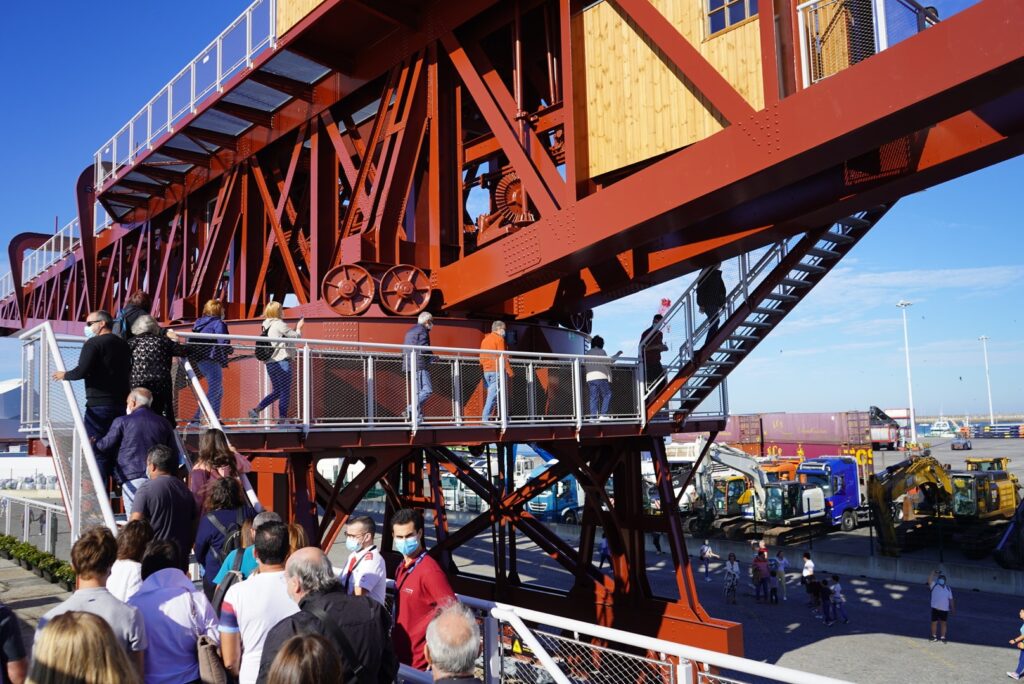

Desde a sua abertura ao público, dezenas de milhares de pessoas já percorreram o circuito do Titan, usufruindo do programa de visitas guiadas a este monumento que assim permanece vivo na memória de todos. (© Sérgio Jacques; Fuente: APDL, 2021).
Since its opening to the public, tens of thousands of people have already walked the Titan circuit, taking advantage of the guided tours programme to this monument that remains alive in everyone’s memory. (© Sérgio Jacques; Source: APDL, 2021).
IMAGEM INICIAL | O “Titan” é ainda considerado o maior guindaste do seu tipo do mundo. (©Sérgio Jacques; Fonte: APDL).
HEAD IMAGE | The “Titan” is still today considered the largest crane of its type in the world. (© Sérgio Jacques; Source: APDL).
╝
REFERÊNCIAS
REFERENCES
ALVES, Jorge Fernandes & TORRES, José Lima – “Douro e Leixões. A vida portuária
sob o signo do bilhete postal” (Douro and Leixões. Port life under the sign of the postal ticket), Porto: Edições ASA, 2002. ISBN 972-41-3213-7.
CLETO, Joel – “Porto de Leixões” (Port of Leixões). Matosinhos: APDL (Matosinhos: Port Administration of Douro, Leixões and Viana do Castelo, S.A.), 1998.
CLETO, Joel – “Titan. O Renascer” (Titan. The Rebirth). Matosinhos: APDL (Matosinhos: Port Administration of Douro, Leixões and Viana do Castelo, S.A), 2022.
PACHECO, Elsa & ALVES, Jorge Fernandes – Porto: a cidade industrial e o sistema portuário (Porto: the industrial city and the port system). “Atas do II Congresso Histórico Internacional. As Cidades na História: Sociedade” (Proceedings of the Second International Historical Congress. Cities in History: Society). Vol. III (Cidade Industrial) (Vol. III Industrial City). Guimarães: Câmara Municipal (Guimarães: Town Hall), 2019. ISBN 978-989-8474-54-4.
SOUSA, Fernando de & ALVES, Jorge Fernandes – “Leixões. Uma história portuária” (Leixões. A history of ports). Matosinhos: APDL (Matosinhos: Port Administration of Douro, Leixões and Viana do Castelo, S.A), 2001.